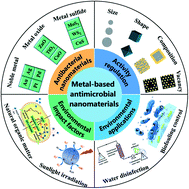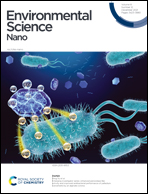Rational design of metal-based antimicrobial nanomaterials in environmental applications
Abstract
Pathogen contamination in natural environments (e.g., air, water, sediments) has become one of the biggest threats to human health. Therefore, developing efficient strategies to control or prevent the growth of pathogenic microbes is urgently needed. With the development of metal-based nanomaterials as antibiotic alternatives, they have attracted ever-growing attention in environmental applications. In this review, we focus on the rational design and environmental applications of metal-based antimicrobial nanomaterials for pathogenic bacteria control. Firstly, the antibacterial properties and mechanisms of typical metal-based nanomaterials are briefly discussed. We then summarize the strategy to enhance the antibacterial performance of metal-based nanomaterials through tuning their physico-chemical properties (e.g., size, shape, facet, vacancy, and composition) and review the effect of typical environmental factors (e.g., dissolved organic matter and sunlight irradiation). Lastly, we present recent progress in the use of metal-based antibacterial nanomaterials for water disinfection and biofouling control. By utilizing the superior bactericidal properties of metal-based nanomaterials, this review could offer guidelines to design innovative devices for the inactivation of bacterial pathogens in the environment.

- This article is part of the themed collection: Nano-bio interactions


 Please wait while we load your content...
Please wait while we load your content...